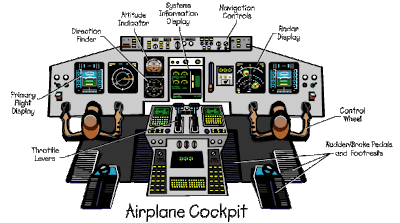Our working memory and short term memory are key in allowing
us to perform simple tasks such as working with an interface. Working memory,
or sensory memory, allows us to work with the information that we take in
before the information actually has a chance to enter our memory. Short term memory allows us to store small amounts
of information without having to commit it to long term memory. These simple,
quick forms of memory storage give us the ability to work with technologies
that would otherwise be overwhelming.
Interfaces, such as cockpit controls, are designed in a way that
give a person the ability to monitor and successfully make use of the controls.
An interface needs to be simple enough for a person to keep up with changes
simply through the use of their working and short term memory. At the same
time, these interfaces need to be able to maintain the attention of the user .
It is a difficult balance that they need to reach when creating these
technologies. The picture below is an example of a cockpit interface. It
is easy to see how a person would need to use their working and short term
memory in figuring out how to use such a large set of controls.
To earn Sona credits this semester, I participated in a
study which required me to use an interface that represented that of an airplane.
It was not very difficult to catch on. I figured out how to complete the task
efficiently, but soon realized that it takes more than just skill to maintain
control over the interface. It also required a lot of focus. Once I had
mastered the task, I was very easily distracted because it was no longer a challenge. It is clear that creating an interface is
more difficult than expected. It would
be extremely important to make sure it is simple enough that it can be use
efficiently, but that it won't bore the operator.
 Auto interiors are a great example of a usable interface. When
driving a car, you often change the music on the radio or adjust the
temperature. These adjustments use simple controls that do not require much
attention. This works out perfectly because the main focus of the driver in a
car should just be driving. In this situation, one can see that the level of
simplicity can be adjusted due to the use of the interface.
Auto interiors are a great example of a usable interface. When
driving a car, you often change the music on the radio or adjust the
temperature. These adjustments use simple controls that do not require much
attention. This works out perfectly because the main focus of the driver in a
car should just be driving. In this situation, one can see that the level of
simplicity can be adjusted due to the use of the interface.
It is difficult to say exactly how to create the perfect
interface, but I think that the first goal should be to create something simple.
The interface is likely to be operated by many different people and these
people need to be able to use it. The user should not have to be concerned with
an overly complex system. The next most important aspect would be to ensure that
the interface maintains the attention of the operator. The interface needs to
be somewhat engaging. The key to achieving this balance would lie within our
working and short term memories. These allow us to experience an interface
without too much confusion. They are what enable us to catch on to how the
interface operates.

No comments:
Post a Comment